Troy, with its 4,000 years of history, is one of the most famous archaeological sites in the world. The first excavations at the site were undertaken by the famous archaeologist Heinrich Schliemann in 1870. In scientific terms, its extensive remains are the most significant demonstration of the first contact between the civilizations of Anatolia and the Mediterranean world. Moreover, the siege of Troy by Spartan and Achaean warriors from Greece in the 13th or 12th century B.C., immortalized by Homer in the Iliad, has inspired great creative artists throughout the world ever since.
The Archaeological Site of Troy has 4,000 years of history. Its extensive remains are the most significant and substantial evidence of the first contact between the civilizations of Anatolia and the burgeoning Mediterranean world. Excavations started more than a century ago have established a chronology that is fundamental to the understanding of this seminal period of the Old World and its cultural development. Moreover, the siege of Troy by Mycenaean warriors from Greece in the 13th century B.C., immortalized by Homer in The Iliad, has inspired great artists throughout the world ever since.
Троя с ее 4000-летней историей — это один из наиболее известных археологических объектов в мире. Его открыл знаменитый археолог Генрих Шлиман в 1870 г. Научная ценность этих богатейших находок состоит в том, что они ярко демонстрируют первые контакты между цивилизациями Анатолии и миром Средиземноморья. Кроме того, осада Трои спартанцами и ахейцами из Древней Греции в XIII-XII вв. до н.э., которую обессмертил Гомер в Илиаде, вдохновляющих людей во всем мире.
Археологические раскопки Трои имеют 4000-летнюю историю. Его обширные останки являются наиболее значительным и существенным доказательством первого контакта между цивилизациями Анатолии и растущим средиземноморским миром. Раскопки, начатые более века назад, установили хронологию, которая является фундаментальной для понимания этого оригинального периода Старого Света и его культурного развития. Более того, осада Трои микенскими воинами из Греции в 13 веке до нашей эры, увековеченная Гомером в «Илиаде» , вдохновляла великих художников всего мира.
Troy, with its 4,000 years of history, is one of the most famous archaeological sites in the world. The first excavations at the site were undertaken by the famous archaeologist Heinrich Schliemann in 1870. In scientific terms, its extensive remains are the most significant demonstration of the first contact between the civilizations of Anatolia and the Mediterranean world. Moreover, the siege of Troy by Spartan and Achaean warriors from Greece in the 13th or 12th century B.C., immortalized by Homer in the Iliad, has inspired great creative artists throughout the world ever since.
The Archaeological Site of Troy has 4,000 years of history. Its extensive remains are the most significant and substantial evidence of the first contact between the civilizations of Anatolia and the burgeoning Mediterranean world. Excavations started more than a century ago have established a chronology that is fundamental to the understanding of this seminal period of the Old World and its cultural development. Moreover, the siege of Troy by Mycenaean warriors from Greece in the 13th century B.C., immortalized by Homer in The Iliad, has inspired great artists throughout the world ever since.
Троя с ее 4000-летней историей — это один из наиболее известных археологических объектов в мире. Его открыл знаменитый археолог Генрих Шлиман в 1870 г. Научная ценность этих богатейших находок состоит в том, что они ярко демонстрируют первые контакты между цивилизациями Анатолии и миром Средиземноморья. Кроме того, осада Трои спартанцами и ахейцами из Древней Греции в XIII-XII вв. до н.э., которую обессмертил Гомер в Илиаде, вдохновляющих людей во всем мире.
Археологические раскопки Трои имеют 4000-летнюю историю. Его обширные останки являются наиболее значительным и существенным доказательством первого контакта между цивилизациями Анатолии и растущим средиземноморским миром. Раскопки, начатые более века назад, установили хронологию, которая является фундаментальной для понимания этого оригинального периода Старого Света и его культурного развития. Более того, осада Трои микенскими воинами из Греции в 13 веке до нашей эры, увековеченная Гомером в «Илиаде» , вдохновляла великих художников всего мира.
Слайд 1
Описание слайда:
Excavations in Troya
Слайд 2
Описание слайда:
Schliemann did in Troy four big campaigns of excavations (1871— 1873, 1879, 1882-1883, 1889-1890). Starting with the third, he began to involve excavation experts. However, the views of experts and the opinion of Schliemann was often at odds. Continued excavation of Troy in 1893— 1894 — Dorpfeld, a trusted employee of the Schliemann, and from 1932 to 1938 — Bledgenom During the last hundred years, unearthed ancient walls of the city began to crumble and crack.
Слайд 3
Описание слайда:
Only in 1988 were able to stop the fatal process of destruction is an international group of archaeologists, led by German Manfred Kohma-dimensional, focused on the preservation of the ancient walls. Since 1992, 75 scientists of different professions from 8 countries, uniting under the banner of the joint project «Troy and Troas. The archaeology of the area», continue to study the Gissarlik hill and its environs. In October 1995, it was discovered that in three of them there was writing In October 1995. I found a bronze seal with Hittite hieroglyphs (1100 BC) Manfred korfman concluded that Troy is the same town that is mentioned not only in Homer, but in the most ancient Hittite epic.
Слайд 4
Описание слайда:
Korfman sure that the latest findings in fortress’s fortifications — an undeniable proof of the truth of the Homeric Troyan war. One way or another, but excavations and research continue of Troy. Ariadna thread of legends leads into the depths of history to a new generation of scientists.
- Главная
- Разное
- Образование
- Спорт
- Естествознание
- Природоведение
- Религиоведение
- Французский язык
- Черчение
- Английский язык
- Астрономия
- Алгебра
- Биология
- География
- Геометрия
- Детские презентации
- Информатика
- История
- Литература
- Математика
- Музыка
- МХК
- Немецкий язык
- ОБЖ
- Обществознание
- Окружающий мир
- Педагогика
- Русский язык
- Технология
- Физика
- Философия
- Химия
- Шаблоны, фоны, картинки для презентаций
- Экология
- Экономика
Содержание
-
1.
Презентация по английскому языку на тему EXCAVATIONS IN TROYA -
2.
The -
3.
Johann Ludwig Heinrich Julius -
4.
2900гг. до н. э — 400 г. н. э. Scientists have -
5.
The Royal tombs at MycenaeOn May 31, -
6.
Слайд 6 -
7.
Слайд 7 -
8.
Thank you for your attention.
The geographic location of Troy Troy, also called Ilion, the ancient fortified settlement in Asia Minor on the Peninsula of Troas on the coast of the Aegean sea, near
Слайд 1EXCAVATONS IN TROYA
Made by
Danilin Vadim Lyceum №4 Form 10
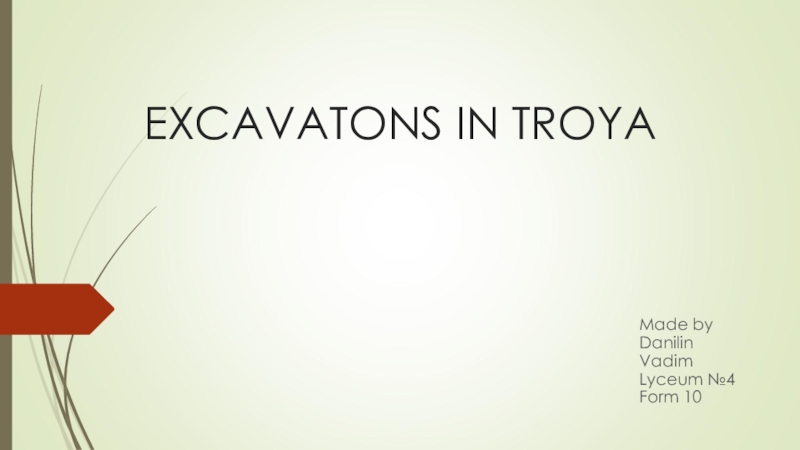
Слайд 2 The geographic location of Troy
Troy, also called Ilion, the ancient fortified settlement in Asia Minor on the Peninsula of Troas on the coast of the Aegean sea, near the entrance to the Dardanelles in the Turkish province of Canakkale.
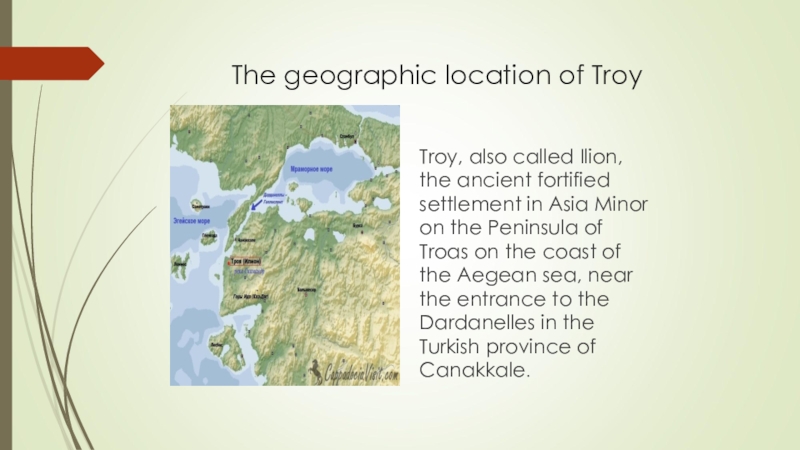
Слайд 3 Johann Ludwig Heinrich Julius
Schliemann
The most famous of archaeologists is Heinrich Schliemann. 140 years ago he discovered the ancient city of Troy and found the famous «treasure of Priam».
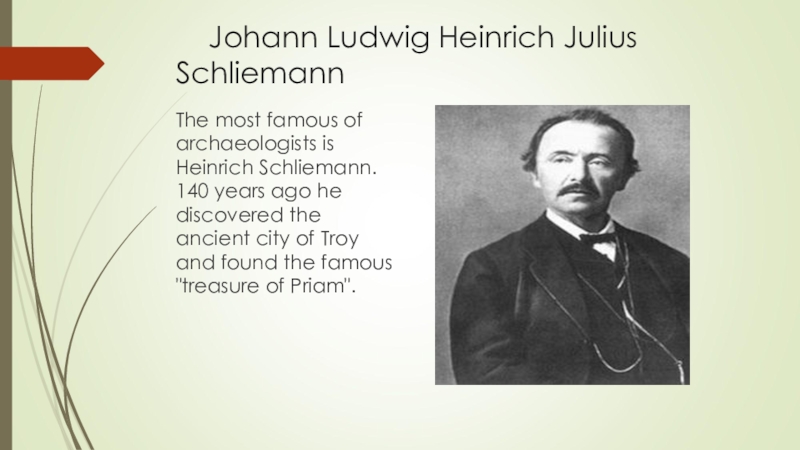
Слайд 42900гг. до н. э — 400 г. н. э.
Scientists have counted 9 layers of
Troy developed from 2900гг. BC to 400 AD. I would like to focus on the period 2600-2300 BC.It is in this «layer» of the times in 1873, the German archaeologist Schliemann found the famous Trojan treasure, which consisted of numerous weapons, copper trinkets, pieces of jewelry, gold vessels, gravestones.
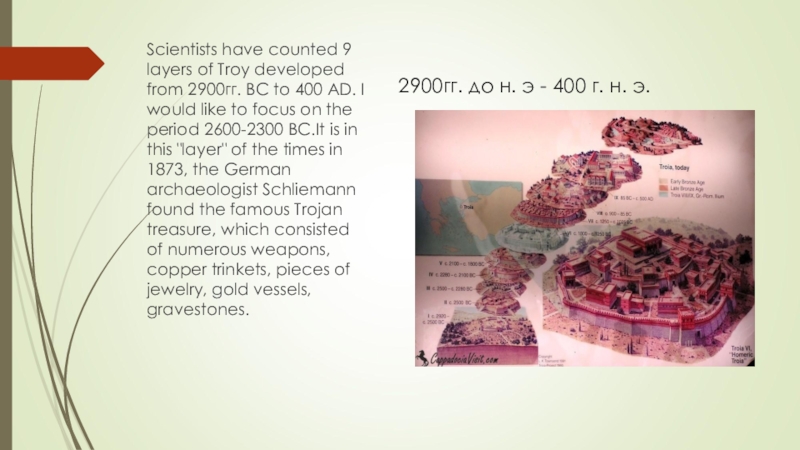
Слайд 5The Royal tombs at Mycenae
On May 31, 1873, Schliemann had discovered
the «Treasure of Priam», named after one of the kings of Troy. Jewelry, military armor, statues and household items were all of gold. A particular value to archaeologists was a gold death mask.
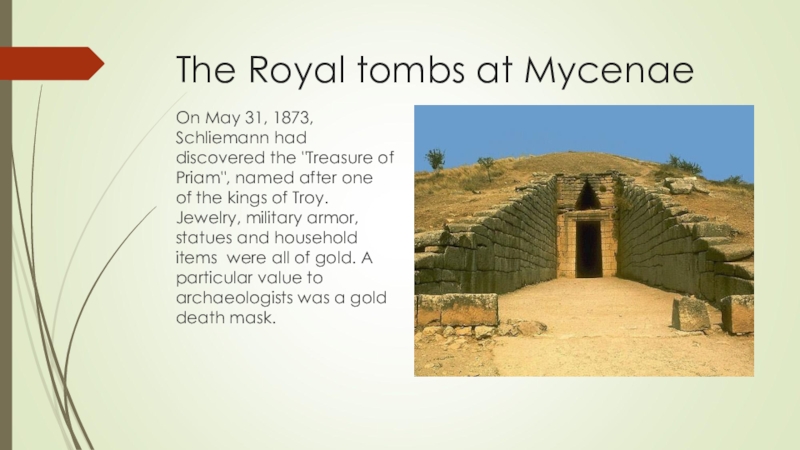
Слайд 6 Communication
In the mid-1980s,
Kazanskiy N. N. published several pieces of clay pottery from Troy with strange characters that resembled the Cretan letter — he called these the signs a Trojan email.
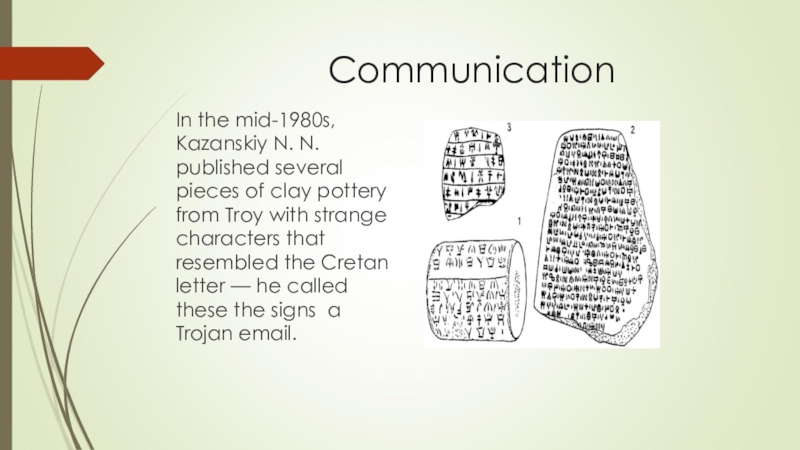
Слайд 7 The search continues!
In the
XXI century the site of Troy has been still studying and the young adventurers still have a chance for new discoveries and unexpected finds.
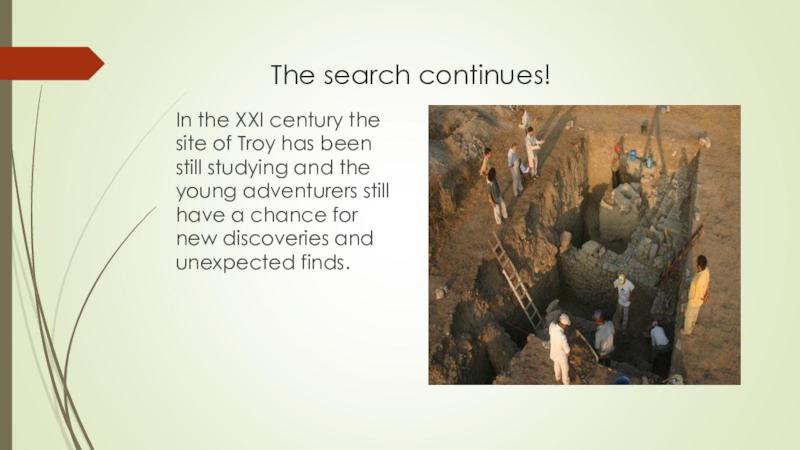
Слайд 8
Thank you for your attention.

Слайд 2«The Iliad» of Homer
Troy is a mythical city, celebrated in
the poem «Iliad» by Homer. A long time Troy was considered a myth, a figment of the imagination of the great Homer, the first who mentioned about it in the Iliad and Odyssey.
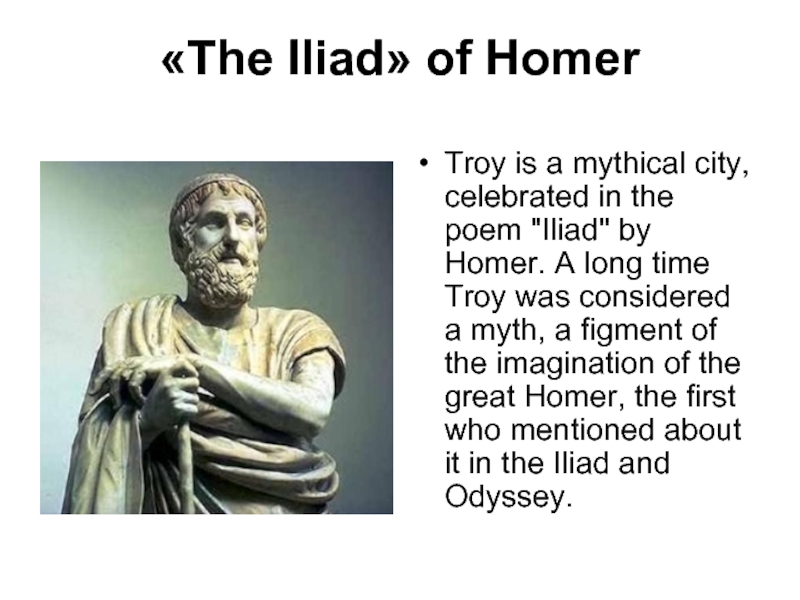
Слайд 3The geographic location of Troy
Troy, also called Ilion, the ancient fortified
settlement in Asia Minor on the Peninsula of Troas on the coast of the Aegean sea, near the entrance to the Dardanelles in the Turkish province of Canakkale.
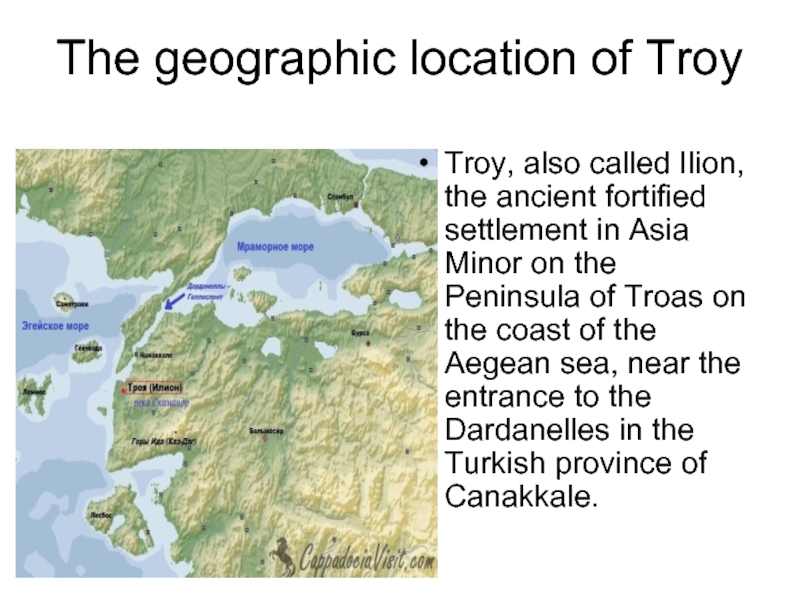
Слайд 4Johann Ludwig Heinrich Julius Schliemann
The most famous of archaeologists is
Heinrich Schliemann , 140 years ago, he discovered the ancient city of Troy and found the famous «treasure of Priam».
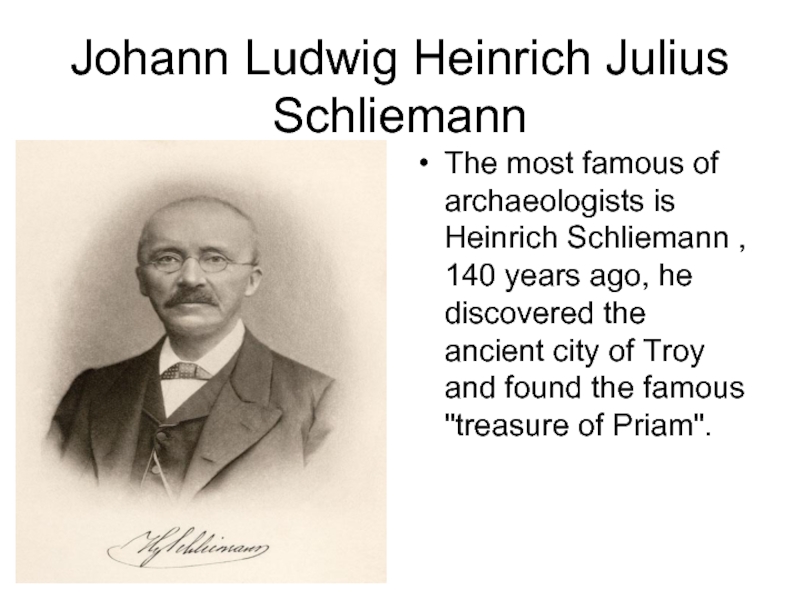
Слайд 52900гг. до н. э — 400 г. н. э.
Scientists have counted 9 layers of
Troy development from 2900гг. BC to 400 ad I would like to focus on the period 2600-2300 BC it is in this «layer» of the times in 1873, the German archaeologist Schliemann found the famous Trojan treasure, which consisted of numerous weapons, copper trinkets, pieces of jewelry, gold vessels, gravestones and prehistoric renaissaince period.
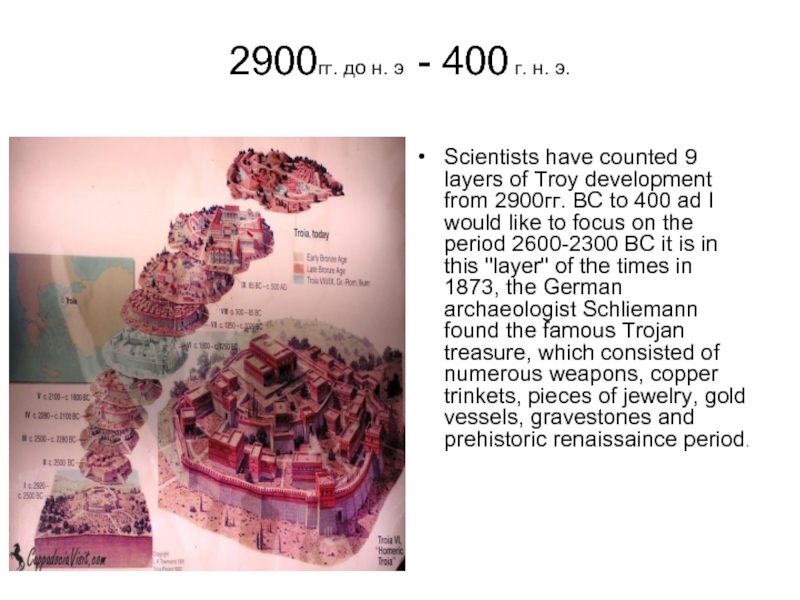
Слайд 6The Royal tombs at Mycenae
May 31, 1873, Schliemann had discovered the
«Treasure of Priam», named after one of the kings of Troy. Jewelry, military armor, statues and household items, were all of gold. Of particular value to archaeologists is found a gold death mask.
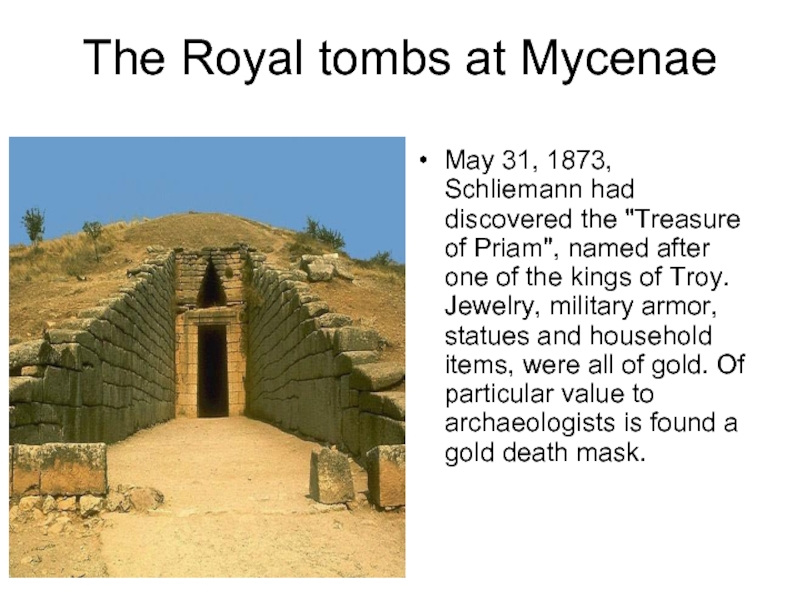
Слайд 7Language and script
In the mid-1980s, Kazanskiy N. N. has published several
pieces of clay pottery from Troy with strange characters that resembled the Cretan letter — he called these the signs of a Trojan email.
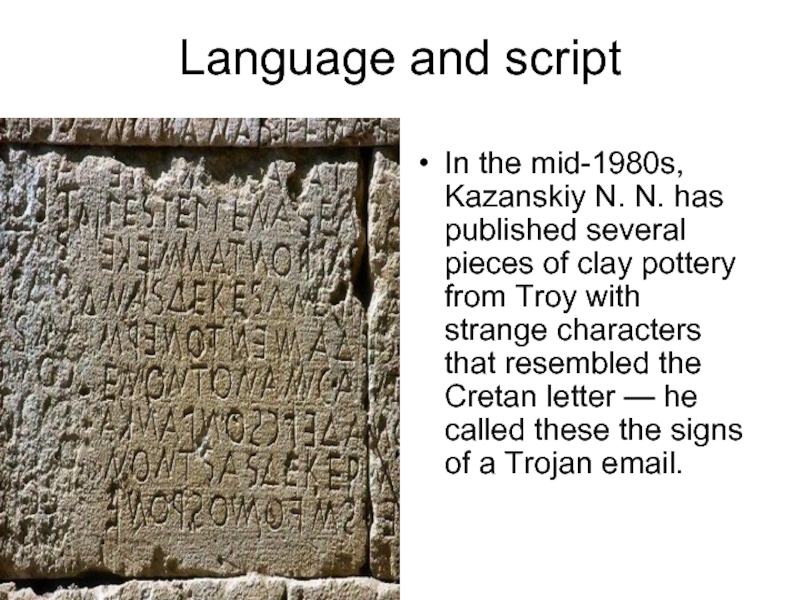
Слайд 8″Gold Of Troy»
7 Feb 1882 in two halls of the Berlin
Museum of arts and crafts was inaugurated the exhibition «Gold of Troy». By 1896, in the collection of Schliemann, there were 8455 exhibits from Troy, not counting the «treasure of Priam». After the death of Schliemann left a will, under which Germany became the heir to his collection.
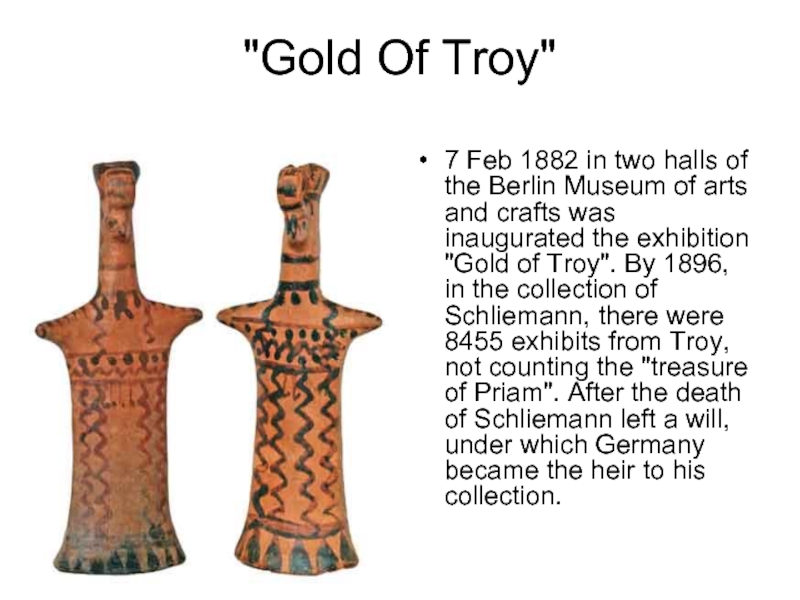
Слайд 9Государственный музей изобразительных искусств
имени А. С. Пушкина
После окончание войны с
Германий в 1945 г. «сокровища Приама» были вывезены из Германии в Россию и по сей день находятся в русских музеях. Если кто то из вас захочет увидеть те археологические находки Трои, то самое близкое место для созерцания это музей имени А. С. Пушкина в Москве.
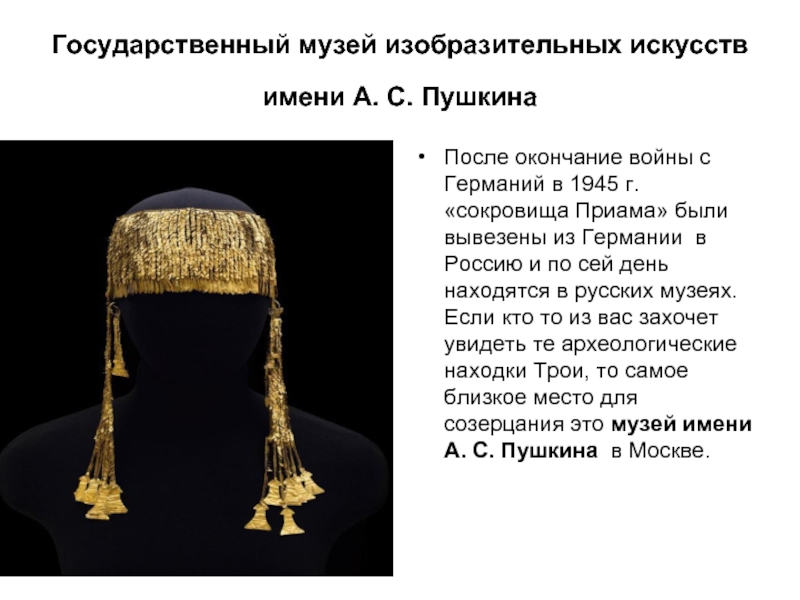
Слайд 10The search continues!
In the twenty-first century on the site of Troy
studied every meter, but the young adventurers still have a chance for new discoveries and unexpected discoveries, because fortune favors the brave!
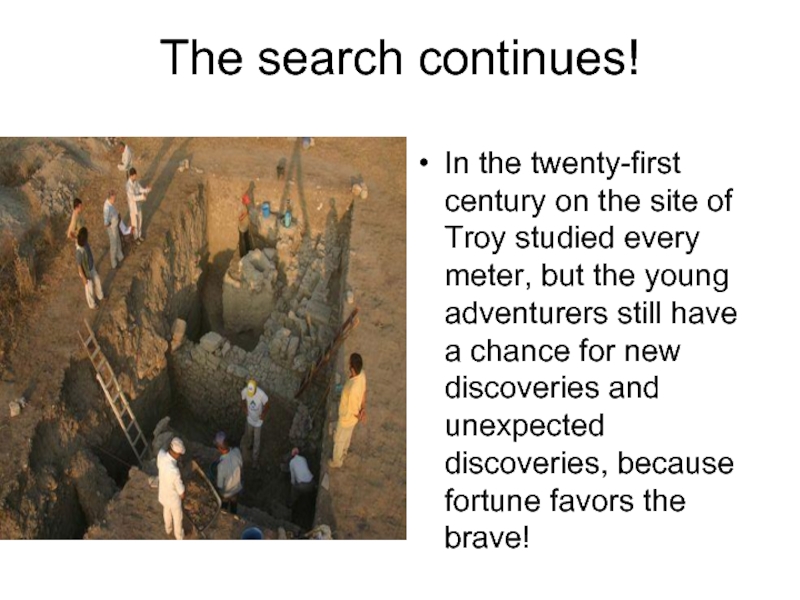
PRESENTATION OUTLINE
2.
Location of Troy
«Troy» and «Ilion» are two different names for the same mighty city in Asia Minor, at the entrance of the Aegean Sea to the Dardanelles (Hellespont). The city was located on the ancient sea trading route that connected the Aegean Sea to the Marmara and Black Seas. Troy dominated the strait and this allowed the city to become a key center of trade between the East and the West in the Bronze Age.
3.
Excavations of Troy in Turkey and the Treasure of Priam
4.
Troy I
The oldest archaeological traces of Troy date back to 2900 — 2500 years. BC e. Troy I was a small settlement and even in the prime of its existence it was only 100 m in diameter. Despite its modest size, Troy I had a fortress with massive walls, gates and towers made of unhewn stone. This settlement existed for almost five centuries and, most likely, was destroyed by fire.
6.
Troy II
Despite the fact that Troy I was destroyed by a fire, which arose at the site of the ashes of Troy II is a revival of the deceased city. The second cultural layer of Troy (2500-2300 BC) is one of the most impressive archaeological sites of the early Bronze Age. Many treasures were discovered in this layer, including the treasure discovered by Schliemann, which he hastily called the “Treasure of Priam”. All these treasures of gold, silver, bronze and copper speak of active trading activities in the city. However, Troy II also collapsed, but as a result of a surprise attack, as evidenced by the detected traces of intentional destruction.
Troy III, IV and V
Troy III, IV and V are already larger settlements that existed from 2300-1800
8.




